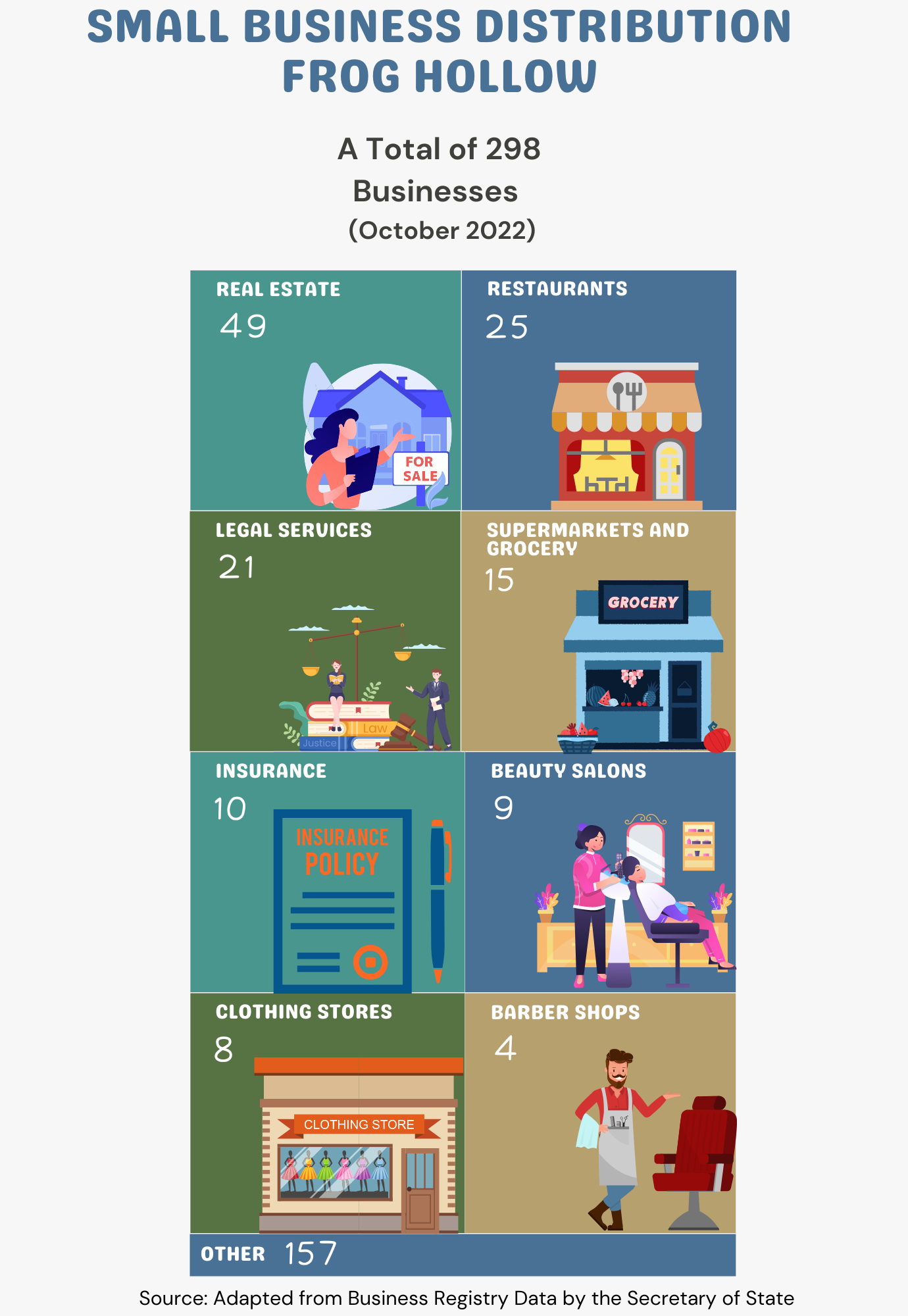Distribution of Small Businesses across Three NRZs
Source: City of Hartford, Small Business Data, October 2018
Source:U.S. Census Bureau, 2016-2020 American Community Survey 5-Year Estimates
Focusing on Frog Hollow
Distribution of Small Businesses by Type:

Source: Adapted from Business Registry Data by the Secretary of State, October 2022
Description of Small Businesses We Surveyed or Interviewed
Our primary data is based on 15 businesses (14 of them are in person face to face interviews, one data point is coming from the online survey we conducted). Businesses we interviewed includes a variety of business types such as hardware store, beauty salon, tattoo shop, bakery, clothing store across the Park Street.
Their employee number ranged between 1 (owner) and 12, majority being between 1-3 employees.
Their revenues changed between $25,000 or less and $5,000,000-$10,000,000. However, we got revenue information only from three businesses out of fifteen who answered our interview or survey.
Majority of their customer profile included locals and regulars from the neighborhood. Though, two of fifteen businesses also mentioned having institutional customers as well as customers with high budgets.
Challenges of Small Businesses
Small businesses we interviewed mentioned facing different challenges, especially during the pandemic. Overall, four of ten businesses who answered the question about the challenges they are facing mentioned safety and security issues. The staff from the jewelry stores shared their concerns about the safety problems in the neighborhood. They have already equipped with very advanced security systems such as cameras and alert systems, but they still want more security in the neighborhood.
Another fashion shop owner wants more parking spots. With people getting more and more vehicles, it’s more difficult for business owners as well as their customers to find a spot during the day. If there are more parking lots, it can also help businesses to attract more customers. Though, it would also be beneficial if the area can attract pedestrians and encourage people visiting the neighborhood by walking and cycling.
Two of ten businesses who answered the question about the challenges they are facing also mentioned weak sales and slow business issues as well as not getting any financial support. One of the businesses complained about the bureaucracy and long formal processes for getting loans in the city.
In-person interviews in the Frog Hollow NRZ also helped us identifying several challenges for small businesses:
- There is a lack of engagement by the city of Hartford Economic Development Office
- There is no coordination between neighborhood community based non-profit organizations and city of Hartford to benefit small businesses in the neighborhood consistently.
- Bureaucracy in the city of Hartford confuses and ties up resources of small businesses that may be better spent elsewhere.
Source: Interview and survey data (15 businesses in total)
Support Systems and Networks of Small Businesses
We also interviewed business owners about their relationship with the community partner organizations, their support systems and ties with NRZs.
Twelve businesses answered our question about their support system and relations with other organizations. Seven businesses mentioned being familiar with The Spanish American Merchant Association (SAMA) and five of them mentioned either having close relations with SAMA or getting assistance with grants. SINA (Southside Institutions Neighborhood Alliance) was also another organization one of the businesses knew about through their personal connections.
While SAMA was cited by some of the businesses (7 out of 12 who answered this question) during the interview process, many others (5) had no connections either to SAMA nor had any connections by outreach by the city of Hartford in reference to small businesses in Frog Hollow.
To our surprise, many residents and shop assistants in the neighborhood did not have knowledge about the NRZs. Ten out of fifteen businesses answered that they had no familiarity or interaction with NRZs. Five of the businesses mentioned either knowing NRZs through their business contacts or personal relations or hearing about them through news.
Source: Interview and survey data (15 businesses in total)
